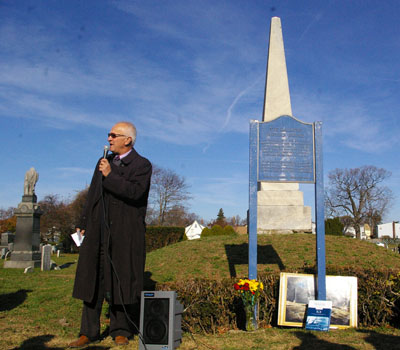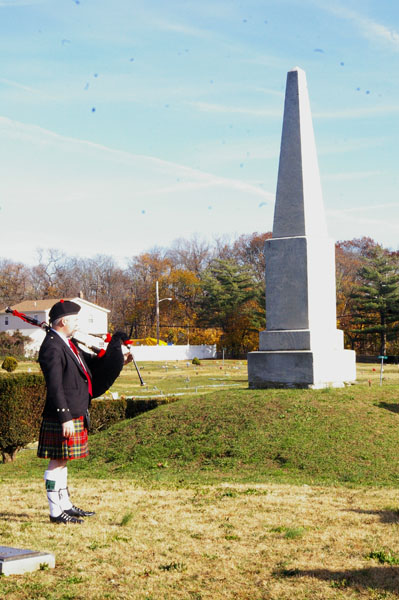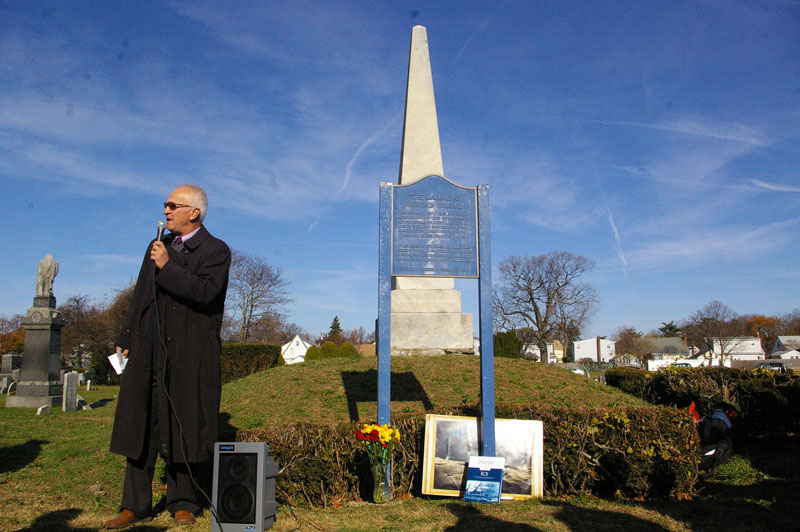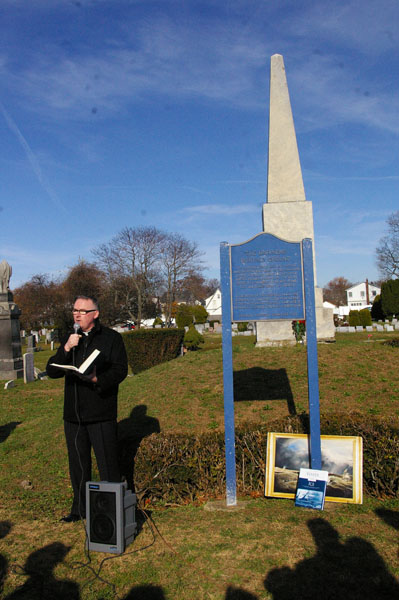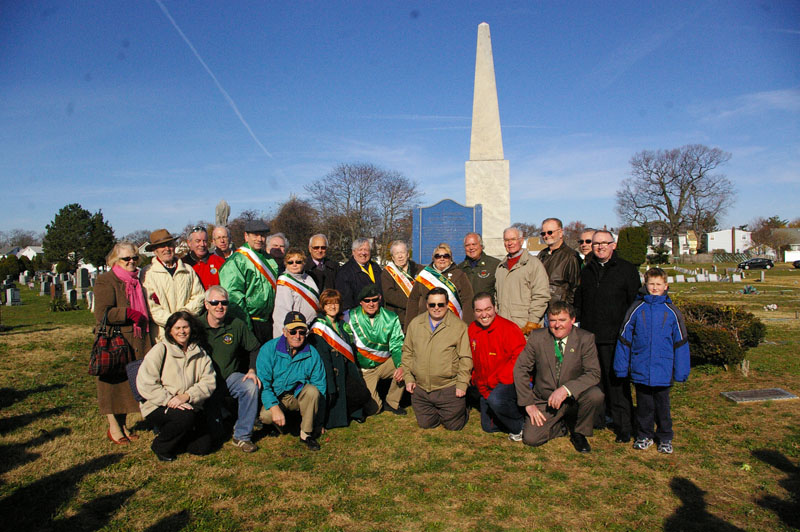Bristol and Mexico Memorial

Nassau County’s Tom Lilly Named National Life Member
November 30, 2011
Merry Christmas
November 30, 2011On November 19th, Nassau County AOH was at the ceremony to remember the Irish immigrants who died in the Bristol and Mexico, both of which sank in 1836 and 1837.
The emigrants are buried in a mass grave in Lynbrook. The memorial service took place at the corner of Merrick Rd and Ocean Ave in Lynbrook (across from US Lumber) at the monument in the cemetery.
About 100 people attended the event, including National Historian Mike McCormack, National Editor John O’Connell, New York State Vice President Jim Burke and Nassau County President Mike Byrne.
Below is an article from the last Hibernian Digest by Mike McCormack:
The immigrant voyage of millions of Irish to America in the nineteenth century was staggering in its hardship. Many know of the Coffin Ships during the Great Hunger and the incredible death toll associated with the 6 to 8 week journey on inadequate vessels designed for hauling cargo rather than passengers. However, little known but just as significant were the tragedies attending those who fled the imposed cruelties in Ireland before the blight even occurred in 1845. Before that tragedy, mass emigration from Ireland accounted for one- third of all traffic across the Atlantic. Between 1825 and 1840, 220,000 Irish emigrated to the U.S. at a time when there were few maritime or immigration regulations in place.
Perhaps none who ventured across the Atlantic seeking a better life had as tragic an end as the 100 Irish men, women and children who set forth on October 16, 1836 on the ship Bristol and the 116 who followed 8 days later on the ship Mexico. Little remembered today, both of these ships wrecked, with a loss of 216 lives, off Long Island’s south shore within weeks of each other. The double-tragedy shocked all who read the spectacular headlines for months to come. The wrecks were among the deadliest maritime accidents in U.S. history up to that time. Their fates brought about sweeping changes in the government’s neglect of the maritime industry, with measures to insure safer travel, including tasking federal ships with sea rescues which evolved into the Coast Guard. So many avoidable deaths so close to land and perishing so horribly, gripped the nation’s emotions. Even Walt Whitman wrote about the event in his poem, The Sleepers, from Leaves of Grass.
I look where the ship helplessly heads end on, I hear the burst as she strikes,
I hear the howls of dismay, They grow fainter and fainter.The Bristol departed Liverpool on Oct. 15 and reached the shores off Far Rockaway on Sunday, November 20 awaiting a pilot escort to guide them through the Narrows. Local boatmen acted as pilots bringing arriving vessels into port safely. Though licensed by the harbor, pilots were generally self-employed. The ship waited for a pilot to arrive, but the New York pilots, who had little regulation and cared less for Irish immigrants, ignored the captain’s signaling, preferring not to work on Sunday! Later that evening, a storm and strong currents drove the Bristol toward Rockaway Shoals. The ship grounded and the captain told the passengers to go below and give the crew a better chance to work on deck. In about an hour, a tremendous wave struck. Life boats and everything moveable were swept off the deck. The hatches were ripped off and the vessel filled with water. Of the 82 steerage passengers below, none but a few close to the hatchways, were saved. Not a sound was heard; death was instantaneous as 60 persons swam unprepared, into eternity.
The Mexico left Liverpool eight days later but had a more difficult crossing, encountering storms and pummeling seas. She took twice as long as the Bristol, to reach New York. Arriving on New Year’s Eve, Captain Charles Winslow signaled for a pilot, but callously, the pilots had adjourned to a Manhattan saloon to ring in the New Year. Winslow tried to keep the ship away from the treacherous shoreline while he waited for a pilot to respond to his signals, but currents and a storm carried his ship to the Long Beach shore. The ship was also overloaded with a cargo of iron bars and coal, which added to the difficulties in controlling her. To the owners, the passengers were simply another commodity, occupying a cargo deck leased to a passenger broker. The crew, weakened by the weeks of battling high winds and flailing seas, and hampered by freezing temperatures, lost both lifeboats in launch attempts. Not till 3 p.m. did a rescue boat reach the Mexico, led by 51-year-old local wreck-master Raynor Smith, who ignored the perils posed to his long boat and six-man crew.
He took in 8 survivors, including Capt. Winslow, 4 crew members, and 3 passengers who had volunteered to help the crew. The remaining famished and terrified passengers were left behind praying that the boat, or others like it, would return for them. As day turned to night, Smith, his crew and other would-be rescuers refused to risk another trip to the Mexico as the seas churned unabated. The weather was so intensely cold, that it was difficult for anyone to remain on deck longer than half an hour at a time. Fifteen minutes after the rescue boat had departed, the ship struck the bottom at Hempstead beach, not more than a cable’s length from the shore. It is believed that none drowned, but all froze to death.
A correspondent for the Morning Courier and New York Express later reported: When (passengers) perceived that no further help came from the land, their piercing shrieks were distinctly heard at a considerable distance, and continued through the night until one by one they diminished. The next morning the bodies of the many unhappy creatures were seen lashed to different parts of the wreck, embedded in ice. Of the 104 victims, two-thirds were women and children, all of whom stood praying on the deck of their broken ship in zero-degree weather just 200 yards off Long Beach where they slowly froze to death in sight of the land of their dreams. Only their tears made it to shore!
Below are pictures from the ceremony by Rose Byrne.

